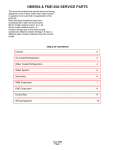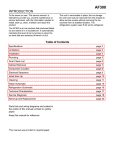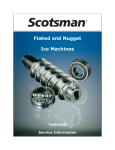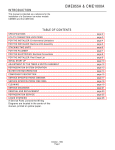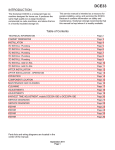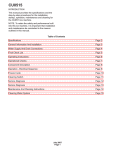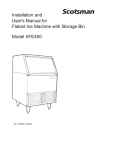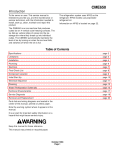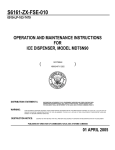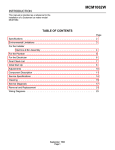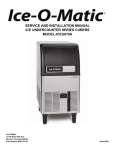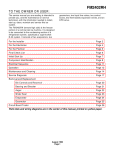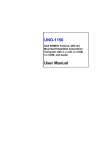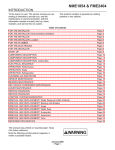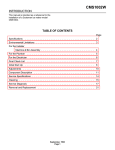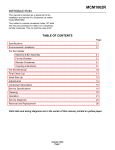Download AFE424
Transcript
AFE424 INTRODUCTION To the owner or user: This service manual is intended to provide you, and the maintenance or service technician, with the information needed to install, start up, clean, maintain and repair this product. The AFE424 is an ice machine that produces flaked ice and stores it in a insulated bin. It automatically maintains the level of ice by turning on when the ice level falls and switches off when it is full. This unit in serviceable in place; the ice storage bin and hood may be removed from the chassis to allow service access without removing the ice machine from its installed location. The refrigeration system uses R-134a as the refrigerant. Table of Contents Specifications · · · · · · · · · · · · · · · · · · · · · · · · · · · · · · · · · · · · · · · · · · · Page 2 For The Installer: Environmental Limitations · · · · · · · · · · · · · · · · · · · · · · · · · · · Page 3 Installation: · · · · · · · · · · · · · · · · · · · · · · · · · · · · · · · · · · · · · · · · · · · · Page 4 Installation: · · · · · · · · · · · · · · · · · · · · · · · · · · · · · · · · · · · · · · · · · · · · Page 5 Installation · · · · · · · · · · · · · · · · · · · · · · · · · · · · · · · · · · · · · · · · · · · · Page 6 Removal of the Cabinet · · · · · · · · · · · · · · · · · · · · · · · · · · · · · · · · · · · · · · Page 7 Component Location · · · · · · · · · · · · · · · · · · · · · · · · · · · · · · · · · · · · · · · Page 8 Electrical Sequence · · · · · · · · · · · · · · · · · · · · · · · · · · · · · · · · · · · · · · · Page 9 Initial Start Up · · · · · · · · · · · · · · · · · · · · · · · · · · · · · · · · · · · · · · · · · · · Page 10 Maintenance and Cleaning · · · · · · · · · · · · · · · · · · · · · · · · · · · · · · · · · · · · Page 11 Maintenance and Cleaning · · · · · · · · · · · · · · · · · · · · · · · · · · · · · · · · · · · · Page 12 Maintenance and Sanitation · · · · · · · · · · · · · · · · · · · · · · · · · · · · · · · · · · · Page 13 Maintenance - Bearing · · · · · · · · · · · · · · · · · · · · · · · · · · · · · · · · · · · · · · Page 14 Water Schematic · · · · · · · · · · · · · · · · · · · · · · · · · · · · · · · · · · · · · · · · · Page 15 Refrigeration Schematic · · · · · · · · · · · · · · · · · · · · · · · · · · · · · · · · · · · · · Page 16 Technical Characteristics · · · · · · · · · · · · · · · · · · · · · · · · · · · · · · · · · · · · · Page 17 Service Diagnosis: Condition - No Ice Being Produced · · · · · · · · · · · · · · · · · · · · · Page 18 Service Diagnosis: Condition - No Ice Being Produced · · · · · · · · · · · · · · · · · · · · · Page 19 Removal And Replacement - Bin Thermostat · · · · · · · · · · · · · · · · · · · · · · · · · · Page 20 Removal And Replacement - Bearings and Seal · · · · · · · · · · · · · · · · · · · · · · · · · Page 21 Removal And Replacement - Current Models · · · · · · · · · · · · · · · · · · · · · · · · · · Page 22 Removal And Replacement - Gearmotor Assembly · · · · · · · · · · · · · · · · · · · · · · · Page 23 Removal And Replacement - Gearmotor Assembly · · · · · · · · · · · · · · · · · · · · · · · Page 24 Removal and Replacement - Evaporator · · · · · · · · · · · · · · · · · · · · · · · · · · · · · Page 25 Removal and Replacement: Refrigeration System · · · · · · · · · · · · · · · · · · · · · · · · Page 26 Keep this manual for reference. April 2010 Page 1 AFE424 Specifications 14.25 IN The nameplate is located on the back panel. A serial number plate is located behind the right grill, in front of the control box, on the base. SERIAL NUMBER PLATE The unit is equipped with an electrical power cord, but should only be plugged into a circuit dedicated to the ice machine. Model Number Dimensions Basic (w/o) legs Electrical HxWxD AFE424A-1 33 x 24 14 x 24 115/60/1 AFE424W-1 same same AFE424A-6 33 x 24 14 x 24 230/50/1 A scoop and legs (6") are included. Ice Type Flake same Flake Condenser Typical Maximum Refrigerant Type Amps Fuse Charge, R-134a. Air 9 15 15 oz same same same 9 oz Air 9 15 15 oz April 2010 Page 2 AFE424 For The Installer: Environmental Limitations The ice machine must be installed indoors in a controlled environment. Minimum Maximum Air Temp 0 50 F. 1000F. Water Temp 400F. 1000F. Water Pressure 20 PSI 80 PSI Voltage (60 Hz) 103.5 126.5 Voltage (50 Hz) 207 253 AIR IN AIR OUT Operating the ice machine outside of the above limitations, or outdoors, is potentially damaging to the machine, and it is misuse of the machine. This may void the warranty. Scotsman Ice Systems are designed and manufactured with the highest regard for safety and performance. They meet or exceed the standards of UL, NSF, and CUL. Scotsman assumes no liability or responsibility of any kind for products manufactured by Scotsman that have been altered in any way, including the use of any part and/or other components not specifically approved by Scotsman. Airflow on air cooled models: · Intake through the right grill. · Exhaust from the left grill. Do not install where this air flow is blocked. The AFE424 has a removable cabinet. When installed, the machine should have some extra clearance (1/8") on the left and right sides so that the cabinet may be easily removed when the machine is in place. Scotsman reserves the right to make design changes and/or improvements at any time. Specifications and design are subject to change without notice. April 2010 Page 3 AFE424 Installation: Water The water supply for this ice machine has been in contact with many materials since it fell from the sky as rain. All rain is slightly acidic, and tends to dissolve the materials it comes in contact with. During water’s journey to the ice machine, it has flowed over and through the ground, been picked up by a municipal or private pump, forced through a series of pipes of differing construction and may have been treated by the municipality providing the water. The water supplied to this ice machine will then contain a variety of substances that will likely show up as solids during the ice making process. These solids are similar to those found when water is boiled out of a saucepan. Only the water boils away, and the minerals that were in the water solidify in the pan. During ice making the water is frozen into ice, and many of the minerals stay behind in the ice machine water system. After time the minerals will have to be dissolved by ice machine cleaner, then flushed away during the cleaning process. An ice machine is a food manufacturing plant; it takes a raw material, in this case water, and transforms it into a food product, ice. The purity of the water is very important in obtaining pure ice and in maximizing product life. The water to the ice machine should be filtered. Water filters vary greatly in ability and function. Install one that filters out suspended solids. The finer the filter the better, but finer filters may plug-up sooner than course ones. It may be necessary to add a course filter ahead of the fine filter to prolong filter life. This ice machine may be installed in the open or under a counter. No clearance is required at the sides or top beyond what’s needed to place the cabinet into position. Air cooled models blow air in and out through the grills at the front. Space is required for utility connections at the back. The ice machine is not designed for outdoor use. It must be installed indoors, in a controlled environment. The air and water temperatures must not exceed rated limits. Electrical power is supplied through a cord connected to the unit. All local codes must be followed. Pre-installation: 1. Inspect the place where the ice machine is to be installed. Check for: · space for the cabinet · water supply, · drain availability · and electrical power supply. No extension cords are allowed. The building drain inlet must be lower than the drain outlet(s) at the back of the ice machine. The water supply must have a hand shut off valve accessible when the unit is installed. 2. Determine the method of installation, is the machine to be installed under the counter? Is the drain in the floor under the machine? Is the water inlet accessible from the top? Have the water tested. Either acidic water or alkaline water will cause corrosion. Dissolved solids cannot be filtered out. Check with a water treatment specialist regarding testing, treatment and filters. Note: Deionized water is not recommended due to its potential corrosive nature and any damage caused by DI water will not be covered by the warranty. April 2010 Page 4 AFE424 Installation: For The Plumber 1. Connect cold potable water to the 3/8" male flare at the top back of the cabinet. A water filter is recommended. Flush the water line prior to connecting to the ice machine. A loop of copper tubing may be used between the ice machine and the water supply. This will allow the ice machine to be pulled out from its installed location without disconnecting the water line. No back-flow preventer is required in the inlet potable water line because provision for that is incorporated in this N.S.F. listed product (the float seat is above the reservoir water level and cannot siphon). 2. Connect a drain tube the drain fitting. If water cooled, the drain tubes must be run separately. The bin drain fitting is 3/4" F.P.T. · Drain tube material must be rigid and meet local code. · Traps in the bin drain line without vents ahead of them will cause poor draining. · The bin drain must be vented if there is a long horizontal run (5’ or more). All drains are gravity, and must have a minimum fall of 1/4" per foot of horizontal run. · Maintain the air gap required by local code between the end of the drain tubes and the building drain receptacle. · Drain tubing should be insulated to prevent condensation from forming on the tubing. 3.The unit is set up for drain connections on the outside of the cabinet. To connect the drains inside would require the removal of the drain fittings attached to the back panel, and field fabricated drain tubes routed inside the base of the unit. AIR COOLED PLUMBING CONNECTIONS POTABLE WATER INLET BIN DRAIN WATER COOLED PLUMBING FLOOR DRAIN RESERVOIR OVERFLOW DRAIN POTABLE WATER INLET CONDENSER DRAIN CONDENSER INLET April 2010 Page 5 AFE424 Installation For The Electrician This is a cord-connected unit, and must be on a separate single phase power supply. Check the nameplate for the correct voltage. The maximum fuse size for this circuit should be 15 amps, per the nameplate use fuses, or HACR circuit breakers. Follow All Local Codes - THIS UNIT MUST BE GROUNDED. Do not use extension cords and do not disable or by-pass ground plug on electrical plug. After Utility Connections: 1. Level the cabinet, use the leg levelers on the end of the legs to adjust the cabinet height. (Legs should have been installed when the unit was unpacked). 2. Wash the bin and hood. If desired, the interior of the bin could be sanitized. 3. Locate the scoop, wash it and have it available for use when needed. Final Check List 1. Is the ice maker cabinet in a room where ambient temperatures are within the minimum and maximum temperatures specified? 2. Has the water supply been connected? 3. Is the water pressure adequate? 4. Have the water connections been checked for water leaks? 5. Have the drain connections been made? 6. Have the drain connections been checked for leaks? 7. Is the cabinet level? 8. Is the ice machine plugged into an electrical power supply of the correct voltage and is the ice machine the only load on that circuit? 9. Has all of the shipping material been removed from the inside of the cabinet? 10. Has the bin and cabinet been wiped clean and sanitized? 11. Has the Customer Evaluation & Warranty Registration form been filled out? Check for correct model and serial numbers from the nameplate, then mail the completed form to Scotsman. 12. Has the owner/user been given the name and telephone number of the authorized Scotsman Service Agency serving that location? April 2010 Page 6 AFE424 Removal of the Cabinet One of the most useful features of this ice machine is the ability to remove the cabinet from the ice machine without removing the ice machine from its installed position. STEP 2 To Remove: 1. Switch the master switch to OFF. Be certain the ice machine has been switched off. 2. Open the bin door and turn the knobs to unscrew the mounting bolts at the left and right inside of the ice storage bin. Remove the mounting bolts. 3. Pull the hood and door assembly straight out until it can be lifted up. Caution: the door may be free to come out the back of the hood when removed from the cabinet base. STEP 3 4. To remove the cabinet base the hood must be removed first. 5. Remove 4 screws and the two grills at the front of the base. 6. In the area exposed when the grills are removed are two knobs similar to those removed in step 2. Unscrew and remove the two knobs. 7. Locate bin drain. Loosen hose clamp holding drain tube to fitting and pull the drain tube off of the fitting. 8. Lift up the front of the base and rotate the base up and off of the ice machine. The machine is now exposed for service. STEP 5 STEP 8 STEP 6 BIN DRAIN April 2010 Page 7 HOOD AFE424 Component Location The ice machine is designed for front service. Many components are serviceable from the front without removing the cabinet. With the cabinet removed, nearly all components are serviceable. In the bin area can be found · Float · Reservoir · Evaporator · Bin Thermostat sensing tube Behind the right front grill on the front edge of the control box: · Bin thermostat · Master switch Inside the control box are the auger delay control, low pressure cut out, and the contactor. Auger Delay Pressure Control: This pressure switch, connected to the low side of the refrigeration system, controls the auger drive motor. High Pressure Cut Out: The pressure switch is designed to open and shut off the machine should the high side refrigeration pressure become too high, usually as a result of not enough water through the water cooled condenser or a fan motor failure. Air cooled is an automatic reset, water cooled is a manual reset. On-Off switch: This toggle switch shuts off the machine. It is not a complete disconnect. Bin Thermostat: This thermostat turns the machine on and off in response to changes in temperature of the capillary tube. At the minimum setting, it opens at 35 0 F. and closes at 450 F. At the maximum setting, it opens at 51oF. and closes at 61oF. See “Initial Start Up” for adjustment information. COVER PLATE CUTAWAY VIEW Air Cooled Shown BIN THERMOSTAT BRACKET RESERVOIR CONTROL BOX HI PRESSURE CUT OUT April 2010 Page 8 AFE424 Electrical Sequence There are two circuits in the AFE424: one is a series circuit with several switches connected in series to the compressor. The other is a parallel branch of the series circuit, controlling the gear drive motor. · The series circuit begins at the contactor in the control box. From there, the line side power is connected to the Master Switch. · From the master switch the line side power is connected to the High Pressure Cut Out. · The line side power is also connected, in a parallel circuit, to terminal 1 of the Auger Delay pressure control. This pressure control, connected to the low side of the refrigeration system, is designed as a by-pass circuit to the auger drive motor whenever the low side refrigerant pressure is at its normal ice making range. At start up, the contacts between terminals 1 and 2 are open. The line side power does not pass any further through the auger delay pressure control until the compressor starts and the low side pressure drops. · The next control the power is connected to is the Low Water Pressure Control. This switch is designed to open should the water pressure to the machine drop too low. · The next control is the Bin Thermostat. It is closed when there is no ice on the portion of the control inside the thermostat bracket. It is open when there is ice on the portion of the control inside the thermostat bracket. Closing of the bin thermostat begins the process of making ice, because the line side power now goes to the compressor contactor coil. · Power is initially connected to the gearmotor · April 2010 Page 9 through contacts 3 and 2 of the auger delay pressure control. This causes the auger motor to start and run. At the same time, if the centrifugal switch on top of the gearmotor closes (meaning the motor is at full speed) the compressor contactor coil is connected to the neutral side of the power supply, and the compressor begins to run. As the compressor operates, the low side or suction pressure begins to fall, when it reaches a preset point, the contacts within it move, opening 3 and 2, then closing 1 and 2. The power for the gearmotor is then connected to a point in the series circuit ahead of the low pressure control, the low water pressure control and the bin thermostat, so that if any of these open, the gearmotor will continue to run, pushing ice out of the evaporator. AFE424 Initial Start Up After the final check list has been gone through, the ice machine may be started up. 1. Open the water shut off valve and allow the reservoir to fill with water. The ice machine will not operate without 20 pounds of water pressure. Note: The reservoir cannot be seen without removing the hood and cover plate, do not adjust float level unless the float does not shut off or overflows out the drain. 2. Remove two screws and the right grill. 3. Locate the master switch and switch it to ON. 4. On air cooled models the fan motor will begin to turn, and warm air will be discharged from the left front of the ice machine. On water cooled models warm water (about 110oF.) will begin to flow from the condenser drain. 5. The water temperature in the evaporator will soon drop below freezing and ice will begin to flow out of the chute. The first bits of ice will not be has hard nor dry as it will after about 10 minutes of ice production. 6. Allow the ice machine to operate for about 20 minutes. Then pour clean water into the bin to melt the ice. This will flush out most manufacturing or shipping materials that may have strayed into the water/ice making system. 7. Check the operation of the bin thermostat by placing ice over the sensing tube. A properly operating bin thermostat will open when ice covers the sensing tube. When the bin thermostat opens, the compressor will stop, but the auger motor will continue to operate, pushing out ice that has formed in the evaporator. The bin will fill with ice until the top of the ice pile covers the bin thermostat sensing tube. At that point the lower part of the ice pile will be very close to the bottom edge of the door opening. Note: The thermostat is adjustable to allow for variations in altitude. Rotating the adjustment knob counterclockwise will adjust the thermostat to open and close at warmer temperatures. Adjustment should not be needed unless the altitude is greater than 2,000 ft. After adjustment, place ice on the thermostat tube to check that the machine shuts off at the new setting. 8. Replace all the grill and close the bin door. The ice machine is now ready for automatic operation. April 2010 Page 10 AFE424 Maintenance and Cleaning Cleaning Schedule: · Scrub the outside and inside of the cabinet frequently with soap and water. · Sanitize the bin interior once a month. · Clean the water system and air cooled condenser a minimum of twice per year. If in an area of high mineral concentration in the water supply, clean water system 4 times a year. This ice machine will perform at its best when kept clean. There are two areas to keep clean: The water system including the water reservoir, auger and evaporator surface; and the air cooled condenser filter and the condenser itself. Air Filter (air cooled only): 1. Remove the grill on the right front of the unit. 2. Remove two screws and the bracket holding the filter to the condenser. 3. Pull the filter forward and twist it slightly to pull it though the slot in the front base of the ice machine. Note: If the unit has been operated without the filter in place, the fins of the condenser will become fouled with dirt, and must be cleaned. Scotsman recommends that only the surface of the condenser be cleaned with the bin in place. A vacuum cleaner with a soft brush attachment will extract most loose dust stuck to the surface of the condenser fins. If there is any doubt about dirt inside the fins of the condenser, the cabinet should be removed and a qualified service agent should clean the condenser. Water cooled units: The water cooled condenser may, over time and under certain water conditions, become internally restricted by minerals. These will have to be dissolved by acid or the condenser replaced. Only a qualified service agent should attempt this type of service. Remove Bracket 4. Wash the surface of the filter off with cold water, or, if torn or so dirty it can’t be cleaned, replace with a new filter. Remove Filter 5. Return the filter to its installed position. 6. Replace the bracket removed in step 2. 7. Replace the grill. Do not operate the unit without the filter in place. April 2010 Page 11 AFE424 Maintenance and Cleaning Cleaning Water System: The water system is cleaned by flowing a mixture of water and Scotsman Ice Machine Scale Remover through the water reservoir into the evaporator and into the ice storage bin as ice. 18. Operate the unit for 15 more minutes, then switch it off. POURING CLEANING SOLUTION INTO RESERVOIR 1. Remove the right and left grills 2. Locate the master switch, and move it to the OFF position. RESERVOIR 3. Empty the bin of ice. 4. Locate knobs holding hood to bin and remove them. 5. Remove hood from ice machine. 6. Locate knobs holding bin to chassis and remove. 7. Disconnect drain hose from bin. 19. Pour clean water into the bin to melt any ice produced during cleaning. 8. Lift up on front of bin and rotate bin off of chassis. Sanitize Water System: 9. Remove cover plate over reservoir. 10. Block the float up to shut off water flow. 11. Locate the evaporator drain, unplug it and drain the evaporator. Re-plug the drain. 12. Place the bin back onto the chassis. 1. Use a locally approved sanitizer or mix a sanitizing solution of 1 ounce of household bleach to 2 gallons of warm (95oF. - 115oF.) water. 2. Disconnect drain hose from bin. 3. Lift up on front of bin and rotate bin off of chassis. 13. Reconnect the drain hose to the bin drain. 14. Mix a solution of 1.5 quarts of warm (950F. 1150F.) water and 4 ounces of Scotsman Clear 1 Ice Machine Scale Remover. 4. Remove cover plate over reservoir. 5. Block the float up to shut off water flow. 6. Locate the evaporator drain, unplug it and drain the evaporator. Re-plug the drain. Scotsman Ice Machine Scale Remover contains acids. These compounds may cause burns. If swallowed, DO NOT induce vomiting. Give large amounts of water or milk. Call Physician immediately. In case of external contact, flush with water. KEEP OUT OF THE REACH OF CHILDREN. 7. Place the bin back onto the chassis. 8. Reconnect the drain hose to the bin drain. 9. Pour the sanitizing solution into the reservoir until it is full and wait 2 minutes. 10. Unblock the float and move the master switch to ON. 11. Operate the unit for at least 15 more minutes, then switch the unit off 12. Discard or melt any ice in the bin.. 13. Thoroughly wash all interior surfaces of the reservoir cover, bin, bin door and hood with the sanitizing solution. 15. Pour the cleaning solution into the reservoir until it is full and wait 20 minutes. 14. Move the master switch to On. 16. Move the master switch to ON, continue to pour cleaning solution into the reservoir until it has all been used. 15. Replace the grills, cover plate and hood. 17. After all of the solution has been poured in, remove the block from under the float. April 2009 Page 12 AFE424 Maintenance and Sanitation The interior liner of the bin is in contact with a food grade product: ice. The storage bin must be cleaned and sanitized regularly to maintain a sanitary environment. Scale that may form on the plastic liner can be removed by scrubbing the surface with a mixture of Scotsman Ice Machine Scale Remover and hot water. Remove any scale prior to cleaning. To Remove Scale: 1. Mix a cleaning solution of 4 ounces of Scotsman Ice Machine Scale Remover to 4 pints of hot (950F.-1100F.) water. Scotsman Ice Machine Cleaner contains acids. These compounds may cause burns. If swallowed, DO NOT induce vomiting. Give large amounts of water or milk. Call Physician immediately. In case of external contact, flush with water. KEEP OUT OF THE REACH OF CHILDREN. Use an approved sanitizer and follow the directions and warnings of that sanitizer or use the following instructions for use of household bleach, if it meets local codes: 1. Mix sanitizing solution of 1 ounce of household bleach to 2 gallons of water. 2. Using clean rubber gloves and a clean cloth, wipe all interior surfaces of ice storage bin, hood and door with sanitizing solution. Be sure and wipe the joint between the hood and bin with the sanitizing solution. Use a clean brush to thoroughly swab all interior surfaces with the sanitizing solution. 3. Reassemble and allow to air dry. Stainless Steel Components Inside Bin The stainless steel parts in the bin also require periodic cleaning. Chemicals in the water supply, such as chlorine, cause brown stains to appear on the surface of the stainless steel parts. 1. General Cleaning - staining is usually removed by washing the parts with ordinary cleaning powder such as Bon-Ami or Copper-Glo and water. After cleaning, rinse with clear water. 2. Water treatment. The chlorine enters the machine from the municipal water supply. It can be removed from the water supply by using a charcoal or activated carbon water filter to treat the water to the ice machine. If staining is severe, filters of this type are recommended. 2. Using rubber gloves, dip a nylon scouring pad into the cleaning solution and scrub the scale off the liner. 3. After the scale has been removed, rinse all surfaces inside the bin with clean, potable water. Exterior Cabinet Cleaning: To Sanitize the bin interior: The exterior cabinet may be cleaned by scrubbing with soap and water. Do not use cleaners containing petroleum products. The hood must be removed from the storage bin so that the joint between the two can be cleaned and sanitized. A nylon type brush may be used to scrub stubborn deposits. To remove the hood: 1. Open the storage bin door and locate the knobs at the right and left inside wall. 2. Unscrew and remove the two knobs. 3. Pull the hood assembly and door straight out from the ice machine. Note: the door may be removed from the back of the hood when the hood is off. April 2010 Page 13 AFE424 Water Schematic Water flows into the ice machine from its inlet connection at the back of the cabinet, through the float valve and into the reservoir. The water in the reservoir then flows by gravity into the bottom of the evaporator. In the evaporator the water chills into ice crystals and is pushed up the evaporator by the auger. At the top of the evaporator, the ice is pressed against a restriction, called a breaker, and some of the water is squeezed out of the crystalline ice. The flaked ice then flows through the chute into the bin. WATER SCHEMATIC EVAPORATOR Water Level RESERVOIR WATER SAFETY SWITCH BIN DRAIN April 2010 Page 14 AFE424 Refrigeration Schematic From the evaporator, the refrigerant flows back to the compressor through the suction line. From the compressor, hot discharge gas is pumped to the condenser, either air or water cooled. At the condenser, heat from the refrigerant flows into the cooling medium, either air or water, and the refrigerant condenses into a liquid. From the condenser the liquid refrigerant flows through the liquid line to the metering device - a thermostatic expansion valve. At the thermostatic expansion valve, the liquid refrigerant passes from a high pressure zone to one of relatively low pressure, and in the low pressure zone it evaporates. The low pressure zone where the refrigerant evaporates is the evaporator. When the refrigerant evaporates, it absorbs heat from the metal parts of the evaporator and the water inside it. EVAPORATOR REFRIGERATION SCHEMATIC SUCTION LINE EVAPORATOR INLET COMPRESSOR GEARMOTOR CONDENSER DISCHARGE LINE THERMOSTATIC EXPANSION VALVE DRYER April 2010 Page 15 AFE424 Service Diagnosis: Condition - No Ice Being Produced STATUS: ICE MAKER DOES NOT OPERATE A. Check: Voltage to the unit, restore it if there is none. Compare to the nameplate. If the voltage is correct and the unit will not start, go to B. B. Check: The master switch, switch ON if off. If the unit does not start go to C. C. Check: The reset switch, (high pressure): on water cooled models depress and release the high pressure reset switch. If the unit still does not start, go to D. The pressure control opens at 250 PSIG (+ or - 30). Normal operation: water cooled - water will flow from the condenser drain; air cooled - the fan blade turns and pulls hot air out of the machine. On water cooled, if the water supply was turned off, the unit will possibly trip on high pressure. If the unit trips out on pressures below 220 PSIG, replace the control. Air cooled models have an automatic reset control. if it does not reset, check the discharge pressure. The control opens at 260 and re-closes at 190. D. Check that the bin thermostat is closed. If open with no ice on it, turn thermostat knob CCW, if this does not close the thermostat, replace it. If the thermostat is closed and the unit will not start, go to E. E. Check the water pressure to the unit. The machine will not run if there is not enough water pressure. Restore/adjust water supply. If the unit will not start with good water pressure, go to F. F. Check that the Auger Delay contacts 3-2 are closed. If open, and the low side (suction) pressure is over 35 PSIG, replace the auger delay pressure control. If contacts 3-2 are closed, and the unit will not start, go to G. G. Check: The gear motor, if it will not run, the compressor will not run. If there is power to the auger drive motor, and it does not run, replace the auger drive motor. If the motor operates, but the compressor will not start, go to H. Note: The gearmotor may not go to full speed if the evaporator bearings are worn or the evaporator needs cleaning. H. If the gearmotor operates, but the compressor contactor coil does not have power, check the centrifugal switch. If the contactor coil does have power but does not pull in, replace the contactor. If all of the above check out, there will be power to the compressor. April 2010 Page 16 AFE424 Service Diagnosis: Condition - No Ice Being Produced STATUS: GEARMOTOR OPERATES, COMPRESSOR DOES NOT Check the compressor 1. Check the compressor start relay. 2. Check the overload. It could be open due to too much heat or too many amps. Too much heat could be too much superheat or not enough refrigerant to cool the compressor. Too many amps could be a relay or internal compressor problem. 3. Check the start capacitor. if its open, the compressor will not start. 4. Check the windings of the compressor for open windings or shorts to ground. Replace those items found defective. STATUS: MAKES ICE, BUT ALSO MAKES EXCESSIVE NOISE. A. Check if the unit has been cleaned recently, it will make extra noise if minerals have stained the auger and/or evaporator. Clean it if in doubt. B. Check the coupling by greasing it. C. Check the bearings for wear. D. Check the evaporator for wear. There are vertical ice guide marks machined into the evaporator’s interior surface, they must be continuous - no horizontal marks are permitted. Vertical sanding of the evaporator interior may be required to clean it. E. Check the gears in the gearmotor, a chipped tooth or worn bearings will cause noise from this area. F. Check other sources of noise, such as the fan motor or compressor. April 2010 Page 17 AFE424 Technical Characteristics Typical Low Side Pressure: · 12 PSIG Typical Discharge Pressure · · · 125 PSIG at 70oF. room air temperature (air cooled) & 50 oF. water 160 PSIG at 90oF. room air temperature (air cooled) & 70 oF. water 135 PSIG water cooled. Refrigerant Type · R-134a Refrigerant Charge: · See page 2 Hi Pressure Cut Out Point: · 250 PSIG - WC · 260 PSIG - AC Typical Compressor Amp Draw · Compressor amps should be about 6 - 7. Superheat · 6-8o F. Air Cooled Fan Motor · 16 watt rating, 1500 RPM, CW Water Cooled Fan Motor · 5 watt rating, 1500 RPM, CW. Gearmotor: · 1/10 H.P., shaded pole motor, 11 RPM output shaft speed. · Gearmotor amps will be about 2.8 - 3.2. Bin Thermostat: · 45o F. cut in, 35o F. cut out (minimum). · 61oF. cut in, 51oF. cut out (maximum). Water Pressure Switch · 10 PSI Cut Out, 20 PSI Cut In Auger Delay Pressure Control - SPDT: · Contacts 3-2 close at · Contacts 1-2 close at 32 PSIG, open at 20 PSIG. 20 PSIG, open at 32 PSIG. April 2010 Page 18 AFE424 Removal And Replacement - Bin Thermostat The bin thermostat controls the On and Off operation of the ice machine. The machine may take a long time to come on if the cabinet is in a cold environment. Do not change a bin thermostat because of reaction time if the ambient temperatures are extreme. It should be changed if, when ice is placed on the tube holder, it does not open within 2 minutes. It should also be changed if, when ice is removed from the tube holder, it does not ever re-close. Electrical shock hazard. Electrical shock can cause personal injury. Disconnect power before beginning to service components. 1. Remove the hood, door and ice storage bin. 2. Remove the control box cover. 3. Locate the bin thermostat at the front of the control box. 4. Remove the two screws holding the control to the control box. 5. Lift the control out of the control box, and pull the two wires off the controls posts. 6. Follow the capillary tube of the bin thermostat and remove it from the grommet in the back of the control box. 7. Pull the end of the bin thermostat from the tube holder. 8. Pull the capillary back through the grommet in the evaporator bracket until free. Remove the bin thermostat from the ice machine. 9. Reverse the above steps to replace. Water on the capillary tube will make the installation into the grommets easier. Caution: Carefully route the bin thermostat capillary tube to be certain that the back curtain does not contact the capillary tube. April 2010 Page 19 AFE424 Removal And Replacement - Gearmotor Assembly Rebuilding The Gearmotor Assembly Removal of the Gearmotor Assembly Drive Motor Parts: 1. Remove the hood, door and ice storage bin.. To replace the centrifugal switch and mechanism or the motor winding or the motor rotor, removal of the gearbox assembly is not necessary. 2. Remove the evaporator and reservoir cover plate. 1. Disconnect electrical power. 3. Unscrew the bolts holding the gearmotor mounting plate to the ice machine chassis. 4. Use a 12" box wrench to unscrew the three cap screws holding the evaporator to the gearmotor. Electrical shock hazard. Electrical shock can cause personal injury. Disconnect power before beginning to service 2. Remove the cover from the top of the centrifugal switch assembly and remove the electric wires from the microswitch. To replace just the centrifugal switch, remove two machine screws retaining the switch, and remove the switch. To replace, reverse the procedure to this point. 3. If the motor is to be removed, the next step is to remove the four screws holding down the plastic switch assembly housing and lift the housing off of the motor top. 4. Remove the centrifugal switch mechanism from the rotor by unscrewing the machine screw at the top of the rotor. 5. The motor and housing may now be removed. Lift off the motor fan housing, and pull off the plastic fan. The next part to be removed is the motor winding. Disconnect the electrical leads of the motor from its control box location and lift off the winding. 6. The rotor is all that remains of the motor in the gear motor assembly. Use a pry bar to carefully pry up the rotor. (The only thing holding it in is the tight fit of the bottom rotor bearing into the top of the gear case.) To replace any of the above parts, reverse the disassembly procedure. 5. Remove the motor and centrifugal switch electrical leads from their connections. 6. Raise the evaporator assembly up enough that the output shaft clears the freezer adaptor. 7. Remove the gearmotor assembly from the ice machine. Gearcase Service After removal of the gear motor from the unit, inspect the internal parts from this gearmotor. 1. Place the gearbox on a flat surface, covered with rags to absorb any spilled lubricant. 2. Using a punch, drive the roll pins out of the casing. 3. Remove the four cap screws on the top of the gearcase and the two under the motor. 4. Pry the two cases apart. When inspecting the internal parts, look for: · Condition and quantity of lubricant. The proper oil level is near the top of the output (biggest) gear. This takes 5 oz. Use Scotsman oil, part number A32379-027. · Bearing condition · Gear and Shaft condition · Woodruff key between output gear and shaft. · Grease seals, back to back. · Vent hole Be sure to count and retain the spacer washers as they come out of the gearbox. Replace the parts as required, using the part numbers found in the parts section of this manual. Replace the gears into a CLEAN bottom gearcase, after adding some grease to the bearings. Replace the spacers in the same quantity as they were removed. If no count was kept, use the numbers found in the parts list. April 2010 Page 20 AFE424 Removal And Replacement Ice Breaker and Auger Removal Note: When the unit is installed under the counter, there is not enough room to remove the auger unless the evaporator is dismounted from the gearmotor or the ice machine is pulled out from under the counter. 1. Remove the hood, door and ice storage bin. 2. Remove stainless steel cover plate. 3. Remove cover from reservoir, and block the float or shut off the water supply. 4. Locate evaporator drain and drain the evaporator/reservoir. 5. Obtain a 1 1/2" pipe thread tee. 6. Remove the sealing cap. Top of Bearing Thrust Washer Thrust Washer and Bearing Sealing Cap 7. Install the Tee, it will screw onto the breaker, which has 1 1/2" NPT threads. 8. Pull up on the Tee or insert a bar thru the Tee and pull up on it to remove the auger and top bearing retainer. When the auger is free, the bolt holding it to the bearing can be removed to allow the bearing retainer to be separated from the auger. Then the bearing can be serviced or the bearing retainer (breaker) replaced. Thrust Bearing Surface April 2010 Page 21 AFE424 Water Seal Installation - all models Inspect the water seal in it’s package. Do no use if mating surfaces are scratched or cracked. 1. Remove auger, unbolt evaporator from adaptor stand. Drive out old bottom bearing and water seal from the top down. 2. Remove the old rotating half of the water seal from the auger and clean the auger at the seal mounting area. 3. Apply Scotsman part number 19-0529-01 food grade sealant to the auger shoulder before pushing on the water seal. Place just enough sealant onto the shoulder of the auger, so that when the water seal is placed on the auger, the gap between the auger shoulder and the water seal is completely filled with the sealant. 4. Clean the inside of the evaporator at the bottom bearing and water seal mounting area. Lubricate the outside edge of the stationary seal with water. 5. Carefully push the stationary part of the water seal up into the bottom of the evaporator. It must go in straight and must not be pushed in beyond 1/4" past the bottom of the evaporator. 6. Install a new bottom bearing, push it into the evaporator under the new water seal. It must be pushed in straight, but do not push it in past 1/8" from the bottom of the evaporator tube. 7. Mount the adaptor stand to the bottom of the evaporator. Hand tighten the three cap screws until the stand flange is tight against the bottom of the evaporator. Hand tighten the three cap screws untilRUBBER SIDE the stand flange is tight against the bottom bearing. Then, tighten the screws in a rotating pattern to insure proper alignment. 8. The top bearing should also be changed at this time. Be sure to mount the top breaker/bearing assembly onto the auger before installing the auger into the evaporator tube. 9. Lower the auger into the evaporator, twist it to engage the splines of the coupling. Secure the breaker and bearing to the evaporator tube with the two screws removed in step 1 of “Ice Breaker and Auger Removal”. Test the unit. SEALANT HERE METAL SIDE WATER SEAL DETAIL April 2010 Page 22 AFE424 Removal And Replacement - Gearmotor Assembly Note: Some bearing grease should be placed in all bearings before assembly to insure proper lubrication upon start up. 4. Bench test the gearmotor assembly. Reassembly Return the gearmotor assembly to the unit. Be certain all mounting surfaces are clean and reassemble to the gearmotor mounting plate. Then bolt back onto ice machine chassis. 1. Set top gearcase on gears and spacers and oil. Be sure O-ring is in place. 2. Drive roll pins back into locating holes. Test for noise, amp draw (must not be in excess of ice maker nameplate for gearmotor) and oil leaks. 3. Replace cap screws into gearcase cover, and torque at 80-90 inch pounds. GEARMOTOR PARTS MOTOR HOUSING OUTPUT SHAFT SEAL FAN STATOR ROTOR FIBER GEAR OUTPUT GEAR BEARING Gasket GEARCASE April 2010 Page 23 AFE424 Removal and Replacement - Evaporator The evaporator may be removed from the ice machine without removing the ice machine from its installed position. The evaporator should only need to be replaced if there is a refrigerant leak in the jacket or it has become worn or pitted internally. 1. Remove the hood, door and ice storage bin.. 12. After the evaporator has been removed from the ice machine, the auger and bearings may be removed. The fasteners, auger, and breaker cover should be saved for use in the new evaporator. New bearings and a water seal will be required when replacing an evaporator. 13. To replace with a new evaporator, install the bearings, water seal and auger in the new evaporator before installing in the chassis. Check the coupling, replace if worn. If the water seal has been leaking, check the interior of the gearmotor for water. 2. Remove the reservoir cover plate. 3. Unscrew the bolts holding the gearmotor mounting plate to the ice machine chassis. 4. Pull the gearmotor forward enough to gain access to the cap screw in the back. Reverse the above steps to replace, braze the two refrigerant joints together, check for leaks. Replace the dryer, evacuate and weigh in the nameplate charge. 5. Use a 12" box wrench to unscrew the three cap screws holding the evaporator to the gearmotor. 6. Shut off water supply. 7. Drain the reservoir and evaporator. 8. Pull water inlet tube off evaporator water inlet. EVAPORATOR ASSEMBLY 9. Remove the refrigerant from the unit. Reclaim, recover or recycle the refrigerant, do not discharge into the air. BEARING CAP 10. Unsweat or cut the liquid and suction line tubes RETAINING to the evaporator at the joints to the left of the SCREWS evaporator. 11. Raise the evaporator assembly up enough that the output shaft clears the freezer adaptor, and remove the evaporator from the ice machine. CAP SCREW THRUST WASHER TOP BEARING EVAPORATOR BREAKER AUGER BOTTOM OF WATER SEAL TOP OF WATER SEAL BOTTOM BEARING COUPLING ADAPTER April 2010 Page 24 AFE424 Removal and Replacement: Refrigeration System If the refrigeration system must be serviced, the quality of service must insure that there will not be a repeat failure, as repeat failures will cause refrigerant to be discharged into the air by the failure or when the failure is corrected. The access valves are at the front of the cabinet, behind the left grill. Access valve caps MUST be on, or the VALVE WILL LEAK. · If there has been a compressor burn out, check for acid in the oil. If acid is indicated, extra steps must be taken to clean up the system. · Never use refrigerant, such as R-11, to clean up or flush out a refrigeration system. When system clean-up is required, the use of suction line filter-dryers and liquid line filter-dryers are recommended. · Always replace the dryer when repairing a leak or replacing a refrigeration component. · Evacuate the system with a good vacuum pump to 300 microns or less. If the triple evacuation method is used, the vacuum should be broken each time with dry nitrogen, not refrigerant. Evacuation must be from both sides of the system. · Weigh in or measure in the nameplate charge. Recharge into the high side. · Check for leaks with a high quality, electronic leak detector. Halide torches will not locate the very small leaks. If an ice machine is to be discarded and still contains refrigerant, Scotsman recommends that the refrigerant be recovered, reclaimed, or recycled so that it is not discharged into the air. Control Box Service The control box may be lifted up from its normal position to improve service access. To Move Control Box 1. Disconnect electrical power. Electrical shock hazard. Electrical shock can cause personal injury. Disconnect power before beginning to service components. 2. Go thru the steps to remove the hood, door and bin. 3. Locate and remove the 3/8" hex head screw holding the control box to the base, just below the purge switch. 4. Pull the control box forward about an inch. 5. The control box may now be moved up the height of the control box, be careful not to kink any capillary tubes. 6. After service, replace the control box in its normal position. April 2010 Page 25



























